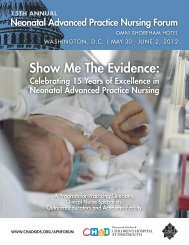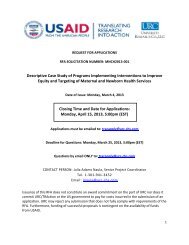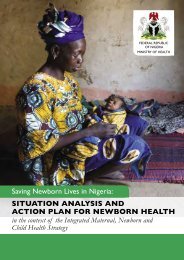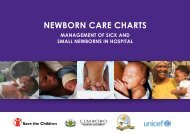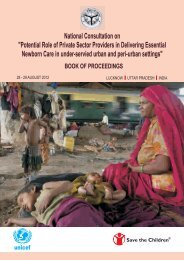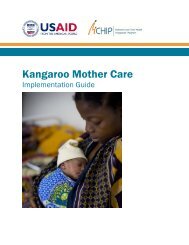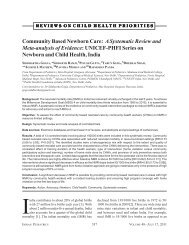Chlorhexidine for Umbilical Cord Care - Healthy Newborn Network
Chlorhexidine for Umbilical Cord Care - Healthy Newborn Network
Chlorhexidine for Umbilical Cord Care - Healthy Newborn Network
- No tags were found...
You also want an ePaper? Increase the reach of your titles
YUMPU automatically turns print PDFs into web optimized ePapers that Google loves.
CASE STUDY<strong>Chlorhexidine</strong> <strong>for</strong> <strong>Umbilical</strong> <strong>Cord</strong> <strong>Care</strong>3. National Regulatory PolicyCHX is included in some national essential medicines lists, but Nepal is the only country known tohave added it to their national essential medicines list at a 4% concentration <strong>for</strong> umbilical cordcare. In other countries it is not at the correct concentration <strong>for</strong> umbilical cord care. Experience inBangladesh and Nepal to date demonstrates that CHX <strong>for</strong> umbilical cord care has been classified bycountry regulatory agencies as a medicine, and the product is required to be registered in countrywith the appropriate drug authority. Over‐the‐counter distribution of the product is independent ofthe need to register the product as a medicine.In 2011, PATH reviewed various global regulatory pathways <strong>for</strong> CHX <strong>for</strong> umbilical cord care.Pathways investigated included United States Food and Drug Administration (USFDA), EuropeanMedicines Agency (EMA), WHO prequalification of medicines, and a country‐by‐country approach.The results of this review suggest that the EMA procedure (termed Article 58) might appear to bepromising in certain respects. Article 58 was established in 2004 to facilitate developing‐countryregistration of medicines to prevent or treat diseases of major public health interest.Per Article 58 requirements, since the CHX product is a simple <strong>for</strong>mulation, regulatory assessmentof the manufacture and control of this drug product would be considered to be standard. Resultsfrom clinical trials in South Asia are also available; however, certain factors make this option lessthan desirable:Significant resources are required to complete an Article 58 application and maintain thepositive scientific opinion resulting from successful submission. It is questionable whether suchcost could be justified when using public funds. Also, it might not make sense to make such aninvestment of several hundreds of thousands of dollars when revenues are expected to be low.The holder of the positive opinion has substantial responsibilities, including post‐opinionsubmission of results from any ongoing and future clinical trials and provision of additionalin<strong>for</strong>mation on the product’s efficacy and safety. Although a nonprofit organization can be anopinion holder, it is questionable whether a nonprofit organization would be willing to assumethose substantial responsibilities on an ongoing basis.Manufacturers would need to ensure manufacture of the product from certified sources ofactive ingredients if the manufacturers were to pursue Article 58. This might increase costs andthere<strong>for</strong>e pricing of the product.Registration of the CHX product on a country‐by‐country basis would still need to beundertaken.Considering the above, a country‐by‐country approach would appear to be the better approach totake to secure registration <strong>for</strong> a CHX product. An expert consultation with WHO should take placeafter publication of recent RCT results in Bangladesh and Pakistan. Favorable findings from thisconsultation, along with an updated listing on the EMLc, will likely facilitate regulatory reviews at6




